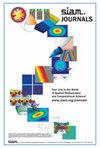Learning Weakly Convex Regularizers for Convergent Image-Reconstruction Algorithms
IF 2.3
3区 数学
Q3 COMPUTER SCIENCE, ARTIFICIAL INTELLIGENCE
引用次数: 0
Abstract
SIAM Journal on Imaging Sciences, Volume 17, Issue 1, Page 91-115, March 2024.Abstract.We propose to learn non-convex regularizers with a prescribed upper bound on their weak-convexity modulus. Such regularizers give rise to variational denoisers that minimize a convex energy. They rely on few parameters (less than 15,000) and offer a signal-processing interpretation as they mimic handcrafted sparsity-promoting regularizers. Through numerical experiments, we show that such denoisers outperform convex-regularization methods as well as the popular BM3D denoiser. Additionally, the learned regularizer can be deployed to solve inverse problems with iterative schemes that provably converge. For both CT and MRI reconstruction, the regularizer generalizes well and offers an excellent tradeoff between performance, number of parameters, guarantees, and interpretability when compared to other data-driven approaches.
学习弱凸正则,实现可收敛的图像重建算法
SIAM 影像科学期刊》第 17 卷第 1 期第 91-115 页,2024 年 3 月。 摘要.我们建议学习非凸正则,并为其弱凸模设定上限。这种正则化器可以产生最小化凸能的变分去噪器。它们依赖于很少的参数(少于 15000 个),并提供了一种信号处理解释,因为它们模仿了手工制作的促进稀疏性的正则器。通过数值实验,我们发现这种去噪器的性能优于凸正则化方法和流行的 BM3D 去噪器。此外,学习到的正则化器可用于解决逆问题,其迭代方案可证明收敛。对于 CT 和 MRI 重建,正则化器都有很好的通用性,与其他数据驱动方法相比,它在性能、参数数量、保证和可解释性之间实现了很好的权衡。
本文章由计算机程序翻译,如有差异,请以英文原文为准。
求助全文
约1分钟内获得全文
求助全文
来源期刊

SIAM Journal on Imaging Sciences
COMPUTER SCIENCE, ARTIFICIAL INTELLIGENCE-COMPUTER SCIENCE, SOFTWARE ENGINEERING
CiteScore
3.80
自引率
4.80%
发文量
58
审稿时长
>12 weeks
期刊介绍:
SIAM Journal on Imaging Sciences (SIIMS) covers all areas of imaging sciences, broadly interpreted. It includes image formation, image processing, image analysis, image interpretation and understanding, imaging-related machine learning, and inverse problems in imaging; leading to applications to diverse areas in science, medicine, engineering, and other fields. The journal’s scope is meant to be broad enough to include areas now organized under the terms image processing, image analysis, computer graphics, computer vision, visual machine learning, and visualization. Formal approaches, at the level of mathematics and/or computations, as well as state-of-the-art practical results, are expected from manuscripts published in SIIMS. SIIMS is mathematically and computationally based, and offers a unique forum to highlight the commonality of methodology, models, and algorithms among diverse application areas of imaging sciences. SIIMS provides a broad authoritative source for fundamental results in imaging sciences, with a unique combination of mathematics and applications.
SIIMS covers a broad range of areas, including but not limited to image formation, image processing, image analysis, computer graphics, computer vision, visualization, image understanding, pattern analysis, machine intelligence, remote sensing, geoscience, signal processing, medical and biomedical imaging, and seismic imaging. The fundamental mathematical theories addressing imaging problems covered by SIIMS include, but are not limited to, harmonic analysis, partial differential equations, differential geometry, numerical analysis, information theory, learning, optimization, statistics, and probability. Research papers that innovate both in the fundamentals and in the applications are especially welcome. SIIMS focuses on conceptually new ideas, methods, and fundamentals as applied to all aspects of imaging sciences.
 求助内容:
求助内容: 应助结果提醒方式:
应助结果提醒方式:


